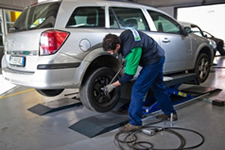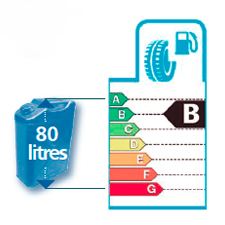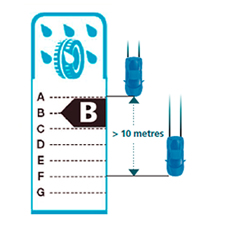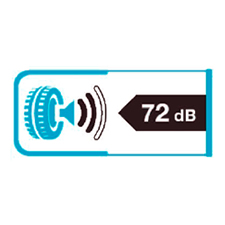When do you need to visit your dealer?
 |
Fitting tyres is a job for professionals.
This delicate operation consists of assembling a unit comprising a wheel, a tyre and a valve, and air/nitrogen for inflation. When the fitting is carried out by tyre specialists this should ensure that any specific instructions are complied with from the tyre manufacturer, vehicle manufacturers and applicable legislation. He They will be able to detect any anomalies liable to affect your safety. |
Consult a tyre professional if any of the following are detected or observed:
- Unusual pressure loss
- Abnormal tyre wear or difference in wear between two tyres on the same axle
- A puncture, cut or deformation and do not use a damaged tyre (at least until it’s been checked and approved by a professional)
- any abnormal occurrence such as vibration, noise or pulling - these must be checked immediately
- Signs of aging,"cracking" even if the tyre is un run or little used (e.g. spare tyre or tyres fitted to trailers)
- If the tyre tread depth is approaching 1.6mm deep
Look out for the NEW Tyre labelling system
 |
Fuel consumption
On the left of the label, an energy efficiency grading indicates the tyre’s contribution to fuel consumption and CO2 emissions.
Tyres are responsible for approximately 20% of a vehicle’s fuel consumption, mainly due to their rolling resistance. Reducing rolling resistance can therefore contribute significantly to improving the energy efficiency of road transport, hence reducing CO2 emissions. In fact, it is the tyre’s rolling resistance level, measured on a machine, which determines its energy efficiency class.
What is the difference between tyres in classes A and G?
This is a considerable difference in rolling resistance, which represents the sort of technical evolution seen over several generations of tyre.
The difference in fuel consumption between a car fitted with A and G class tyres is around 0.5 litres per 100 km (approx. 4mpg). |
 |
Wet Braking
On the right of the label is a scale grading the tyre’s wet road braking performance. Measurements are made on a vehicle under conditions defined by the European Regulation (speed, track characteristics, water depth, temperature ...). |
 |
Exterior Noise
Traffic noise is a major source of nuisance. The lower part of the label shows the level of exterior tyre noise emitted from the vehicle (not the interior tyre noise level heard by the driver) expressed in decibels. |
The Dealer Experience
Before the Dealer
Preparation is key, at this stage of tyre academy you already now know:
- The importance of a tyre.
- The legal tread limit is 1.6mm.
- How to read the information on the sidewalls.
So use this information to your advantage, you can now plan to ensure the tyre is no longer a distress purchase.
At the Dealership/Garage:
Explain to the dealer your own personal set of circumstances, they are the experts. If your driving is mainly motorway based or predominantly the school run, this will affect your tyre purchasing criteria.
As with anything you get what you pay for and a tyre is no exception. Choose from the three tiers of tyre product:
- Premium – The most expensive, typically your more well-known brands with the most advanced materials and technology used. Giving you the highest levels of performance.
- Second Line – These are you mid-range priced tyre, typically produced by smaller firms however most large tyre manufacturers have their own second line brand.
- Budget – These are of course the cheapest option, they are produced to the same regulations and standards are the others but with lower quality, less durable materials and with less research and development input.
Don’t be afraid:
It is a good idea to take the dealers advice; after all they are the experts. However for several reasons, stock, availability or margin the dealer may steer you towards a particular tyre. But remember you have done your research; they don’t need to be a distress purchase. Plan and get the most from your tyres.
If they say “They need replacing soon” you are entitled to ask why, they will be happy to explain to you if you ask.
Dealer Add-ons and Extras
- Balancing – Highly recommended it is done each time a tyre is fitted. When the wheel rotates, an imbalance may cause it to hop or wobble, which can cause ride disturbances, usually vertical and lateral vibrations coming back into the car.
- Valves – Highly recommended a new value is fitted at each tyre change. Your tyre valve is a small rubber or metal device attached to the rim that controls the flow of air by opening or closing.
- Scrap and used tyres – Are tyres that are no longer suitable for use on vehicles due to wear or irreparable damage. The cost of disposing of a tyre in an environmentally responsible way will often be passed onto you so feel free to enquire about it.
Tracking and Alignments – Highly recommended it is done each time a tyre is fitted. Consist of adjusting the angles of the wheels so that they are set to the car maker's specification. (Your will learn more about this in section 2 of tyre academy)
What’s next?
Now you’ve been through all three modules in Level 1, it’s time to see what you’ve learnt. Click below to start the test survey. It’s quite simple, so if you’ve read the modules, you’ll know the answers.
Once you’ve completed the quiz, Level 2 will be waiting for you. This level builds on the information we’ve provided through level 1 and simply gives you more detail. There are more key facts about tyre maintenance and the ‘Key safety checks part 2’ module is well worth a read if you want to understand more about the jargon you get from your local tyre fitment centre. |

